 W
WHardware stores, sometimes known as DIY stores, sell household hardware for home improvement including: fasteners, building materials, hand tools, power tools, keys, locks, hinges, chains, plumbing supplies, electrical supplies, cleaning products, housewares, tools, utensils, paint, and lawn and garden products directly to consumers for use at home or for business. Many hardware stores have specialty departments unique to its region or its owner's interests. These departments include hunting and fishing supplies, plants and nursery products, marine and boating supplies, pet food and supplies, farm and ranch supplies including animal feed, swimming pool chemicals, homebrewing supplies and canning supplies. The five largest hardware retailers in the world are The Home Depot, Lowe's, Kingfisher of the United Kingdom, Obi of Germany, and Leroy Merlin of France.
 W
WA badge tether or badge reel is a spring-loaded reeled tether that resembles a button badge in appearance or attachment. It is used to avoid damage to or the loss of small important objects kept on-person that need to be accessed frequently or quickly, such as a ski pass, identification card or badge, name badge, keys, a phone or other handheld device, or a penknife or other small tool.
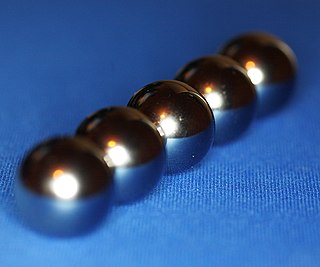 W
WBearing balls are special highly spherical and smooth balls, most commonly used in ball bearings, but also used as components in things like freewheel mechanisms. The balls come in many different grades. These grades are defined by bodies such as the American Bearing Manufacturers Association (ABMA), a body which sets standards for the precision of bearing balls. They are manufactured in machines designed specially for the job.
 W
WA Belleville washer, also known as a coned-disc spring, conical spring washer, disc spring, Belleville spring or cupped spring washer, is a conical shell which can be loaded along its axis either statically or dynamically. A Belleville washer is a type of spring shaped like a washer. It is the frusto-conical shape that gives the washer its characteristic spring.
 W
WA bushing or rubber bushing is a type of vibration isolator. It provides an interface between two parts, damping the energy transmitted through the bushing. A common application is in vehicle suspension systems, where a bushing made of rubber separates the faces of two metal objects while allowing a certain amount of movement. This movement allows the suspension parts to move freely, for example, when traveling over a large bump, while minimizing transmission of noise and small vibrations through to the chassis of the vehicle. A rubber bushing may also be described as a flexible mounting or antivibration mounting.
 W
WA coupling is a device used to connect two shafts together at their ends for the purpose of transmitting power. The primary purpose of couplings is to join two pieces of rotating equipment while permitting some degree of misalignment or end movement or both. In a more general context, a coupling can also be a mechanical device that serves to connect the ends of adjacent parts or objects. Couplings do not normally allow disconnection of shafts during operation, however there are torque-limiting couplings which can slip or disconnect when some torque limit is exceeded. Selection, installation and maintenance of couplings can lead to reduced maintenance time and maintenance cost.
 W
WA D-ring is an item of hardware, usually a tie-down metal ring shaped like the letter D used primarily as a lashing point. The term is found interchangeably spelled in different forms, such as: Dring, d-ring or Dee-ring.
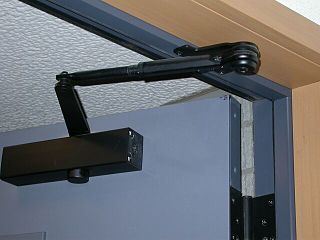 W
WDoor furniture or door hardware refers to any of the items that are attached to a door or a drawer to enhance its functionality or appearance.
 W
WA ferrule is any of a number of types of objects, generally used for fastening, joining, sealing, or reinforcement. They are often narrow circular rings made from metal, or less commonly, plastic. Ferrules are also often referred to as eyelets or grommets within the manufacturing industry.
 W
WA floating hinge is a hinge that, while able to behave as a normal hinge, enables one of the objects to move away from the other - hence float. In effect the hinge allows for two parallel axes of rotation, one for each object joined by the hinge, and each axis can be moved relative to the position of the other.
 W
WA geared continuous hinge is a type of continuous hinge used mostly on doors in high-traffic entrances and features gear teeth that mesh together under a cap that runs the length of the hinge. The hinges use a number of fasteners to attach the door to the frame from top to bottom to distribute a door’s weight more evenly along the frame to stop doors from sagging. They are often used in schools, hospitals, hotels, offices, airports, stadiums, storefronts and many other commercial and industrial buildings.
 W
WA grease fitting, grease nipple, Zerk fitting, grease zerk, or Alemite fitting is a metal fitting used in mechanical systems to feed lubricants, usually lubricating grease, into a bearing under moderate to high pressure using a grease gun.
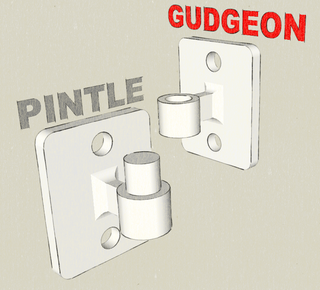 W
WA gudgeon is a socket-like, cylindrical fitting attached to one component to enable a pivoting or hinging connection to a second component. The second component carries a pintle fitting, the male counterpart to the gudgeon, enabling an interpivoting connection that can be easily separated. Designs that may use gudgeon and pintle connections include hinges, shutters and boat rudders.
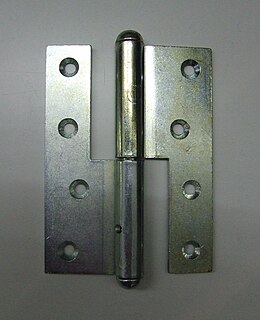 W
WA hinge is a mechanical bearing that connects two solid objects, typically allowing only a limited angle of rotation between them. Two objects connected by an ideal hinge rotate relative to each other about a fixed axis of rotation: all other translations or rotations being prevented, and thus a hinge has one degree of freedom. Hinges may be made of flexible material or of moving components. In biology, many joints function as hinges like the elbow joint.
 W
WA mechanical joint is a section of a machine which is used to connect one or more mechanical part to another. Mechanical joints may be temporary or permanent, most types are designed to be disassembled. Most mechanical joints are designed to allow relative movement of these mechanical parts of the machine in one degree of freedom, and restrict movement in one or more others.
 W
WThe HurriQuake nail is a construction nail designed by Ed Sutt for Bostitch, a division of Stanley Works, and patented in 2004. The features of the nail are designed primarily to provide more structural integrity for a building, especially against the forces of hurricanes and earthquakes.
 W
WA pintle is a pin or bolt, usually inserted into a gudgeon, which is used as part of a pivot or hinge. Other applications include pintle and lunette ring for towing, and pintle pins securing casters in furniture.
 W
WA pullstring, pullcord, or pullchain is a string, cord, or chain wound on a spring-loaded spindle that engages a mechanism when it is pulled. It is most commonly used in toys and motorized equipment. More generally and commonly, a pullstring can be any type of string, cord, rope, or chain, attached to an object in some way used to pull or mechanically manipulate part of it.
 W
WA reduction drive is a mechanical device to shift rotational speed. A planetary reduction drive is a small scale version using ball bearings in an epicyclic arrangement instead of toothed gears.
 W
WA rubber washer is a ring made of rubber used in mechanical devices. It is used to prevent vibration from spreading from one part to another, reducing the noise levels.
 W
WThe shaft collar is a simple, yet important, machine component found in many power transmission applications, most notably motors and gearboxes. The collars are used as mechanical stops, locating components, and bearing faces. The simple design lends itself to easy installation.
 W
WA shear pin is a mechanical detail designed to allow a specific outcome to occur once a predetermined force is applied. It can either function as a safeguard designed to break to protect other parts, or as a conditional operator that will not allow a mechanical device to operate until the correct force is applied.
 W
WA shim is a thin and often tapered or wedged piece of material, used to fill small gaps or spaces between objects. Shims are typically used in order to support, adjust for better fit, or provide a level surface. Shims may also be used as spacers to fill gaps between parts subject to wear.
 W
WIn general, a spacer is a solid material used to separate two parts in an assembly. Spacers can vary in size from microns to centimeters. They can be made of metal, plastic, glass, and other materials. Shapes include flat sheet, cylindrical and spherical.
 W
WA stair rod, also commonly referred to as a carpet rod, is an ornamental decorative hardware item used to hold carpeting in place on steps.. Traditionally, stair rods were used to hold a carpet runner in place on stairs, but with superior carpet installation techniques and more rigid safety standards today, stair rods serve primarily a decorative purpose. Stair rods are however still an integral part of many installation techniques. They hide dimples in the carpet runner caused by installation staples or nail heads and they are also often required to conceal a pattern mismatch when the carpet runner is cut during installation at each step where the tread meets the riser.
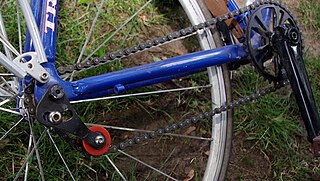 W
WA tensioner is a device that applies a force to create or maintain tension. The force may be applied parallel to, as in the case of a hydraulic bolt tensioner, or perpendicular to, as in the case of a spring-loaded bicycle chain tensioner, the tension it creates. The force may be generated by a fixed displacement, as in the case of an eccentric bicycle bottom bracket, which must be adjusted as parts wear, or by stretching or compressing a spring, as in the case of a spring-loaded bicycle chain tensioner; by changing the volume of a gas, as in the case of a marine riser tensioner; by hydraulic pressure, as in the case of a hydraulic bolt tensioner; or by gravity acting on a suspended mass, as in the case of a chair lift cable tensioner. In the power sector, the tensioner is a machine for maintaining constant tension of the conductors during work of hanging the transmission network..
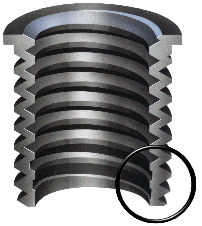 W
WA threaded insert, also known as a threaded bushing, is a fastener element that is inserted into an object to add a threaded hole. They may be used to repair a stripped threaded hole, provide a durable threaded hole in a soft material, place a thread on a material too thin to accept it, mold or cast threads into a work piece thereby eliminating a machining operation, or simplify changeover from unified to metric threads or vice versa.
 W
WA trunnion is a cylindrical protrusion used as a mounting or pivoting point. First associated with cannons, they are an important military development.
 W
WA turnbuckle, stretching screw or bottlescrew is a device for adjusting the tension or length of ropes, cables, tie rods, and other tensioning systems. It normally consists of two threaded eye bolts, one screwed into each end of a small metal frame, one with a left-hand thread and the other with a right-hand thread. The tension can be adjusted by rotating the frame, which causes both eye bolts to be screwed in or out simultaneously, without twisting the eye bolts or attached cables.
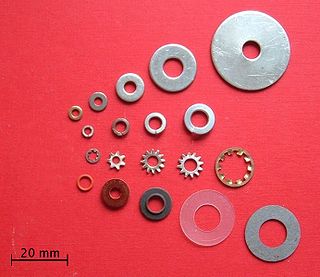 W
WA washer is a thin plate with a hole that is normally used to distribute the load of a threaded fastener, such as a bolt or nut. Other uses are as a spacer, spring, wear pad, preload indicating device, locking device, and to reduce vibration. Washers often have an outer diameter (OD) about twice their inner diameter (ID), but this can vary quite widely.
 W
WA wire is a single usually cylindrical, flexible strand or rod of metal. Wires are used to bear mechanical loads or electricity and telecommunications signals. Wire is commonly formed by drawing the metal through a hole in a die or draw plate. Wire gauges come in various standard sizes, as expressed in terms of a gauge number. The term 'wire' is also used more loosely to refer to a bundle of such strands, as in "multistranded wire", which is more correctly termed a wire rope in mechanics, or a cable in electricity.